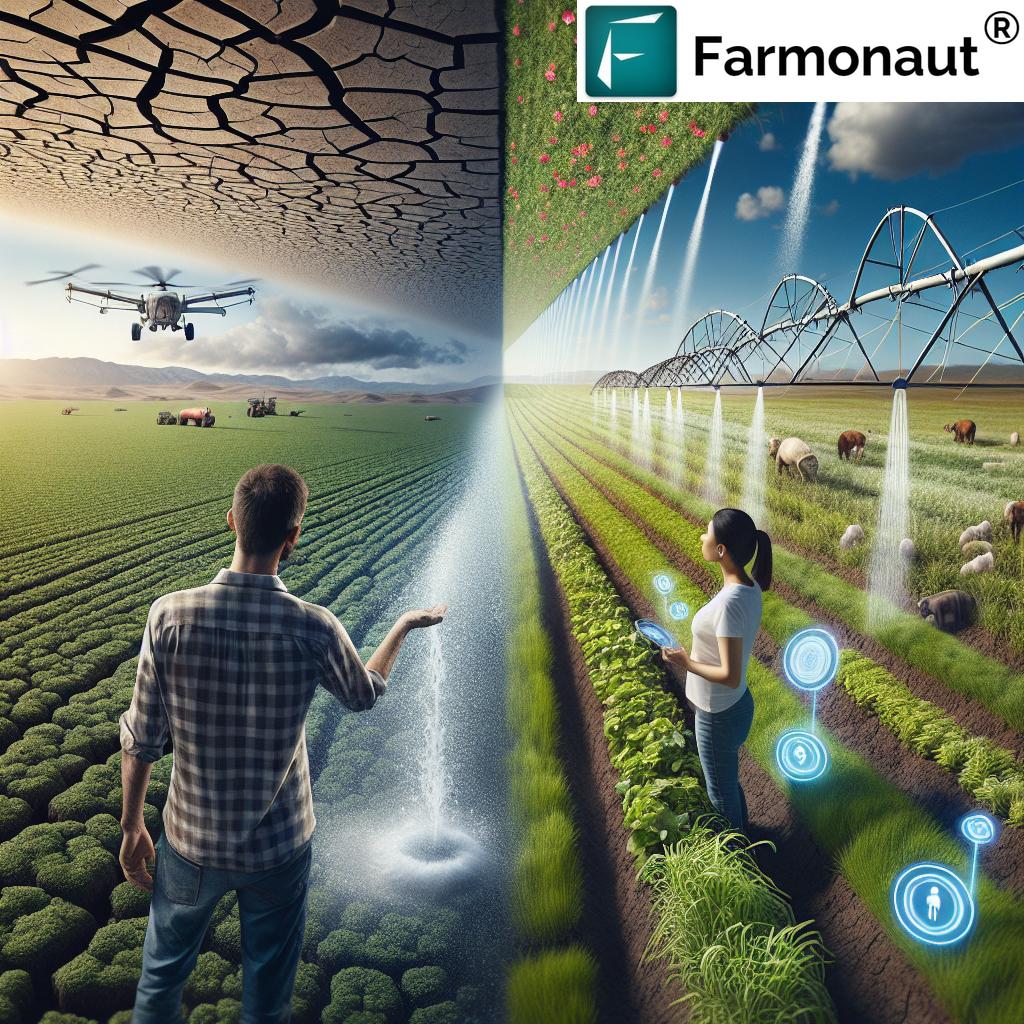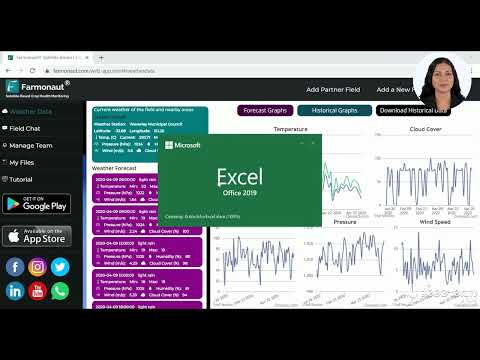Revolutionizing Agriculture: How Farmonaut’s Smart Farming Tech Combats Drought in Texas and Nebraska
“Hurricane Helene’s aftermath and persistent dry spells have impacted crops and livestock in the Southeast and Nebraska.”

In recent years, the agricultural landscape of the United States has been dramatically reshaped by unprecedented weather events and persistent drought conditions. Farmers in Texas, Nebraska, and the Southeast are facing extraordinary challenges as they grapple with the aftermath of Hurricane Helene and prolonged dry spells. These climate-related adversities have significantly impacted crops and livestock, pushing the agricultural sector to seek innovative solutions for survival and sustainability.
In this comprehensive blog post, we’ll explore how cutting-edge agricultural technology solutions and sustainable farming practices are revolutionizing the industry, enhancing climate resilience, and combating drought. We’ll delve into the world of precision agriculture techniques and smart farming technologies that are optimizing crop yields and improving irrigation efficiency. Additionally, we’ll examine the shortcomings of federal drought relief policies and highlight community-driven disaster recovery efforts.
As we navigate through these topics, we’ll showcase how Farmonaut’s advanced remote sensing technology is empowering farmers to make data-driven decisions, ultimately building resilience in an ever-changing agricultural landscape. Let’s embark on this journey to understand the challenges faced by farmers in Texas and Nebraska, and discover the innovative solutions that are shaping the future of agriculture.
The Drought Dilemma: A Closer Look at Texas and Nebraska
The United States Department of Agriculture (USDA) has reported alarming drought conditions across vast regions of Texas and Nebraska. These two states, known for their significant contributions to the nation’s agricultural output, are experiencing severe to exceptional drought levels. Let’s examine the specific challenges faced by farmers in these regions:
- Texas: The Lone Star State has been grappling with prolonged periods of dry weather, affecting both crops and livestock. The southeastern parts of Texas, in particular, have seen a dramatic reduction in soil moisture levels, impacting the production of key crops such as cotton, corn, and sorghum.
- Nebraska: Known as the Cornhusker State, Nebraska’s agricultural sector has been hit hard by persistent drought conditions. The state’s corn and soybean yields have suffered significantly, with many farmers reporting substantial crop losses.
The impact of these drought conditions extends beyond crop yields. Livestock farmers in both states are facing challenges in maintaining adequate water supplies for their animals and securing sufficient feed due to poor pasture conditions. The ripple effects of these agricultural setbacks are felt throughout local communities, affecting everything from food prices to rural economies.
Smart Farming Technologies: A Ray of Hope
In the face of these daunting challenges, smart farming technologies are emerging as a beacon of hope for farmers in Texas, Nebraska, and beyond. These innovative solutions are helping farmers adapt to changing climate patterns, implement water conservation strategies, and leverage data-driven insights for more effective farm management.
At the forefront of this agricultural revolution is Farmonaut, a pioneering agricultural technology company that offers advanced, satellite-based farm management solutions. Through its android, iOS, web/browser App, and API, Farmonaut is making precision agriculture affordable and accessible to farmers worldwide.
Key features of Farmonaut’s smart farming technology include:
- Real-time crop health monitoring using satellite imagery
- AI-based advisory systems for personalized farm management
- Blockchain-based traceability for enhanced supply chain transparency
- Resource management tools for optimized farm operations
These technologies are particularly crucial in drought-prone areas like Texas and Nebraska, where efficient resource management can make the difference between crop success and failure.
Precision Agriculture Techniques for Drought Mitigation
Precision agriculture is at the heart of modern drought mitigation strategies. By utilizing data-driven insights and targeted interventions, farmers can optimize their resource use and maximize crop yields even in challenging conditions. Here are some key precision agriculture techniques that are making a difference:
- Satellite-Based Crop Monitoring: Farmonaut’s satellite imagery technology allows farmers to monitor crop health remotely, identifying areas of stress before they become visible to the naked eye. This early detection enables timely interventions, potentially saving crops from drought-related damage.
- Precision Irrigation: Smart irrigation systems use soil moisture sensors and weather data to deliver water precisely where and when it’s needed. This not only conserves water but also ensures optimal plant health.
- Variable Rate Technology (VRT): VRT allows farmers to apply inputs like fertilizers and pesticides at varying rates across a field, based on specific soil and crop needs. This targeted approach reduces waste and improves overall crop resilience.
- Climate-Smart Crop Selection: Data-driven insights help farmers choose crop varieties that are best suited to local climate conditions and more resistant to drought.
“Farmonaut’s advanced remote sensing technology helps farmers make data-driven decisions across thousands of acres.”
Farmonaut’s Role in Combating Drought
Farmonaut’s suite of smart farming technologies is playing a crucial role in helping farmers in Texas and Nebraska combat the effects of drought. Here’s how Farmonaut’s solutions are making a difference:
- Satellite-Based Crop Health Monitoring: Farmonaut uses multispectral satellite images to provide farmers with real-time insights into vegetation health (NDVI) and soil moisture levels. This information is critical for early detection of drought stress and enables timely interventions.
- Jeevn AI Advisory System: This AI-driven tool delivers personalized farm advisory services, including weather forecasts and expert crop management strategies. By analyzing satellite data and other inputs, Jeevn AI helps farmers make informed decisions about irrigation, fertilizer usage, and pest management in drought conditions.
- Resource Management Tools: Farmonaut’s platform includes features for efficient resource management, helping farmers optimize water usage and reduce waste – a critical factor in drought-prone areas.
- Weather Data Integration: By integrating comprehensive weather data, Farmonaut helps farmers prepare for and respond to changing weather patterns, including drought conditions.
Explore Farmonaut’s API for advanced weather and satellite data integration

Sustainable Farming Practices for Long-Term Resilience
While smart farming technologies provide immediate solutions, implementing sustainable farming practices is crucial for long-term resilience against drought and other climate challenges. Here are some sustainable practices that farmers in Texas and Nebraska are adopting:
- Cover Cropping: Planting cover crops during off-seasons helps improve soil health, increase water retention, and reduce erosion – all critical factors in drought resilience.
- Conservation Tillage: Reduced or no-till farming practices help maintain soil structure and organic matter, improving water infiltration and retention.
- Crop Rotation: Rotating crops can improve soil health, break pest cycles, and enhance overall farm resilience.
- Agroforestry: Integrating trees and shrubs into crop and animal farming systems can provide shade, reduce water evaporation, and improve soil health.
These sustainable practices, when combined with smart farming technologies like those offered by Farmonaut, create a powerful toolkit for farmers facing drought conditions.
Check out Farmonaut’s API Developer Docs for integration details
Federal Drought Relief Policies: Challenges and Opportunities
While technological solutions and sustainable practices are crucial, federal support plays a vital role in helping farmers weather severe drought conditions. However, current federal drought relief policies have shown some inadequacies in addressing the complex challenges faced by farmers in Texas and Nebraska. Let’s examine some of these issues:
- Reactive vs. Proactive Approach: Many federal policies are designed to provide relief after drought damage has occurred, rather than supporting preventive measures.
- Limited Scope: Some relief programs don’t adequately address the full range of drought impacts, such as long-term soil degradation or economic ripple effects in rural communities.
- Accessibility Issues: Small and medium-sized farms often face challenges in accessing federal relief due to complex application processes or eligibility criteria.
- Insufficient Focus on Technology Adoption: There’s a need for more robust support for farmers adopting water-saving technologies and precision agriculture tools.
Despite these challenges, there are opportunities for policy improvement. Increased support for technology adoption, streamlined relief processes, and a greater emphasis on proactive drought resilience measures could significantly enhance the effectiveness of federal drought relief efforts.
Community-Driven Disaster Recovery Efforts
In the face of federal policy limitations, community-driven disaster recovery efforts have emerged as a crucial support system for farmers in drought-affected areas. These grassroots initiatives often provide more immediate and targeted assistance. Here are some ways communities in Texas and Nebraska are coming together to support their agricultural sectors:
- Local Water Conservation Programs: Communities are implementing water-sharing agreements and conservation incentives to help farmers manage limited water resources more effectively.
- Farmer-to-Farmer Networks: Experienced farmers are sharing drought-coping strategies and best practices with their peers through local networks and workshops.
- Community-Supported Agriculture (CSA) Programs: These programs provide farmers with upfront financial support from consumers, helping to mitigate some of the financial risks associated with drought conditions.
- Local Food Banks and Donation Programs: Communities are organizing food banks and donation programs to support farmers who have experienced significant crop losses due to drought.
These community-driven efforts, combined with technological solutions like Farmonaut’s platform, create a multi-faceted approach to drought resilience.
Weather Forecasting Tools: Preparing for Future Seasons
Accurate weather forecasting is crucial for farmers in drought-prone regions like Texas and Nebraska. Advanced weather prediction tools, including those integrated into Farmonaut’s platform, are helping farmers prepare for future seasons and make informed decisions about planting, irrigation, and harvesting. Here’s how these tools are making a difference:
- Long-Term Climate Predictions: Seasonal forecasts help farmers plan crop selection and rotation strategies months in advance.
- Short-Term Weather Alerts: Real-time weather alerts enable farmers to take immediate action to protect crops from sudden weather changes.
- Historical Weather Data Analysis: By analyzing past weather patterns, farmers can identify trends and adjust their strategies accordingly.
- Integration with Farm Management Systems: Weather data integrated directly into farm management platforms like Farmonaut allows for automated adjustments to irrigation and other farm operations.
The Old Farmer’s Almanac, a time-honored resource for weather predictions, is also being complemented by these modern forecasting tools, providing farmers with a comprehensive view of potential weather patterns.
Adapting to Changing Climate Patterns
As climate patterns continue to evolve, farmers in Texas and Nebraska must adapt their practices to ensure long-term sustainability. Here are some strategies being employed:
- Diversification of Crops: Planting a variety of crops with different water requirements and drought tolerances can help spread risk.
- Water-Efficient Irrigation Systems: Implementing drip irrigation and other water-saving technologies to maximize water use efficiency.
- Soil Health Management: Focusing on improving soil organic matter to increase water retention capacity.
- Climate-Resilient Crop Varieties: Adopting crop varieties bred for drought tolerance and heat resistance.
Farmonaut’s technology plays a crucial role in this adaptation process by providing farmers with the data and insights needed to make informed decisions about these strategies.
Comparison of Drought Impact and Smart Farming Solutions
| State | Drought Severity | Crop Impact | Traditional Methods | Farmonaut’s Smart Farming Solutions |
|---|---|---|---|---|
| Texas | Severe to Extreme | 20-40% yield reduction | Reduced planting, manual irrigation | Precision Irrigation: 30% water savings Crop Health Monitoring: Early stress detection |
| Nebraska | Moderate to Severe | 15-30% yield reduction | Crop rotation, drought-resistant varieties | AI Advisory: Optimized crop selection Satellite Monitoring: Real-time field insights |
The Future of Agriculture: Integrated Smart Farming Solutions
As we look to the future, the integration of smart farming technologies like those offered by Farmonaut with sustainable farming practices will be key to building resilient agricultural systems in drought-prone regions. Here’s what the future might hold:
- AI-Driven Farm Management: Advanced AI systems will provide increasingly accurate and personalized recommendations for farm management, from crop selection to harvest timing.
- IoT Integration: The Internet of Things (IoT) will connect various farm sensors and equipment, creating a seamless network of data collection and automated responses to changing conditions.
- Predictive Analytics: Big data analytics will enable more accurate long-term predictions of climate trends, helping farmers plan years in advance.
- Blockchain for Traceability: Blockchain technology will enhance supply chain transparency, allowing consumers to trace their food from farm to table and potentially rewarding farmers for sustainable practices.
Farmonaut is at the forefront of these developments, continuously evolving its platform to meet the changing needs of farmers in Texas, Nebraska, and beyond.
Conclusion: Building a Resilient Agricultural Future
The challenges posed by drought conditions in Texas and Nebraska are significant, but the combination of innovative technologies, sustainable practices, and community support is paving the way for a more resilient agricultural future. Farmonaut’s smart farming solutions are playing a crucial role in this transformation, providing farmers with the tools they need to make informed decisions, optimize resource use, and adapt to changing climate patterns.
As we continue to face the realities of climate change, the agricultural sector must embrace these technological advancements and sustainable practices. By doing so, we can ensure food security, support rural economies, and build a more sustainable future for generations to come.
The journey towards drought resilience is ongoing, but with continued innovation, collaboration, and the right tools at our disposal, farmers in Texas, Nebraska, and across the United States can look forward to a future where they’re not just surviving in the face of climate challenges, but thriving.
Frequently Asked Questions (FAQ)
- How does Farmonaut’s technology help farmers combat drought?
Farmonaut’s satellite-based crop monitoring, AI advisory systems, and resource management tools help farmers detect early signs of drought stress, optimize water usage, and make data-driven decisions to mitigate drought impacts. - What are some sustainable farming practices that can improve drought resilience?
Key practices include cover cropping, conservation tillage, crop rotation, and agroforestry. These methods improve soil health, water retention, and overall farm resilience. - How can farmers access Farmonaut’s smart farming solutions?
Farmers can access Farmonaut’s platform through their web app, mobile apps (available on Android and iOS), or by integrating Farmonaut’s API into existing farm management systems. - What role do community-driven efforts play in agricultural disaster recovery?
Community initiatives like local water conservation programs, farmer-to-farmer networks, and community-supported agriculture provide crucial support and resources to farmers affected by drought. - How is climate change affecting agriculture in Texas and Nebraska?
Climate change is leading to more frequent and severe droughts, changing precipitation patterns, and increased temperature variability, all of which pose significant challenges to crop and livestock production in these states.
By leveraging smart farming technologies like Farmonaut and adopting sustainable practices, farmers in Texas, Nebraska, and beyond can build resilience against drought and other climate-related challenges, ensuring a sustainable future for agriculture.






